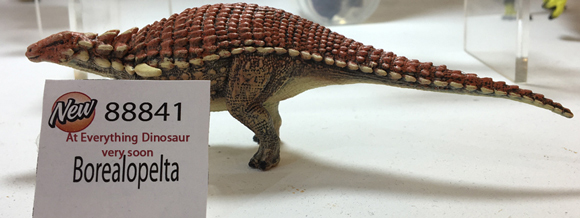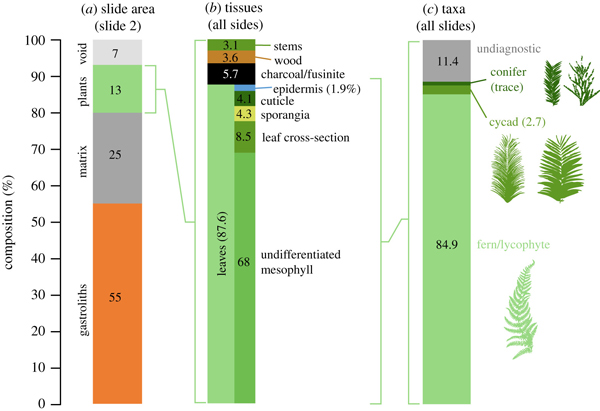Borealopelta was a Fussy Eater
Borealopelta markmitchelli Stomach Contents Analysed
The stomach contents of a giant armoured dinosaur which was named and described in 2017, have revealed what this herbivore ate just hours before it died. The incredibly rare fossilised stomach contents indicate that the 5.5 metre-long Borealopelta markmitchelli was a fussy eater, selecting one type of fern but ignoring others. The charcoal preserved with the stomach remains also reveals that this dinosaur was probably picking over the fresh growth following a recent forest fire, a behaviour seen amongst many large extant herbivores. Growth rings identified in a small twig inside the dinosaur’s body cavity suggest that this dinosaur died in the late spring/mid-summer.
Borealopelta markmitchelli Life Reconstruction – The Last Day of a Nodosaur
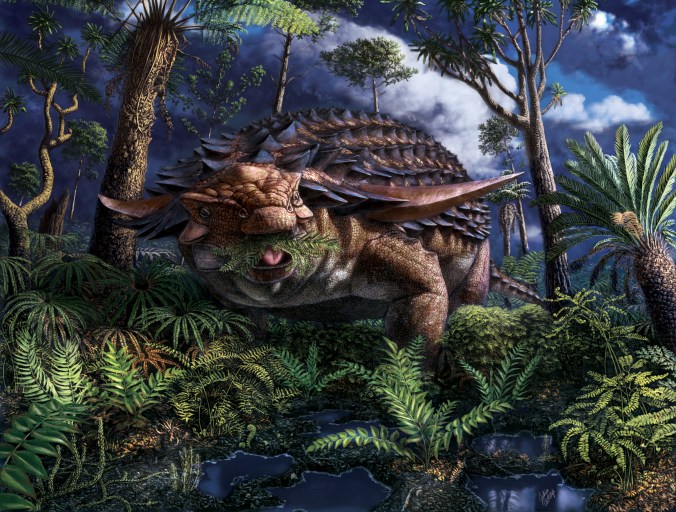
Picture credit: Julius Csotonyi
The Cololite Reveals All
Writing on the open-access, The Royal Society publishing platform, the scientists which include Caleb Brown and Donald Henderson from the Royal Tyrrell Museum of Palaeontology (Alberta), along with colleagues from Brandon University (Manitoba) and the University of Saskatchewan, provide a detailed analysis of the stomach contents of Borealopelta markmitchelli, the most comprehensive direct evidence of diet in an herbivorous Mesozoic dinosaur, helping palaeontologists to better understand the palaeoecology of armoured dinosaurs.
Direct evidence of diet in herbivorous dinosaurs is exceptionally rare in the fossil record, but with this beautifully preserved Borealopelta specimen, the presence of a cololite (fossil stomach or intestinal contents), permitted the team to conduct a forensic examination of the dinosaur’s last meal.
The small ankylosaur Kunbarrasaurus ieversi from the Early Cretaceous of Australia, which was named in 2015, is described as preserving a cololite within the abdominal cavity (specimen number QMF18101). Whilst the Kunbarrasaurus material has proved not to be as diagnostic as the cololite associated with Borealopelta, its location in relation to the body, does help to support the idea that the football-sized mass found with Borealopelta does indeed represent stomach contents.
The Stomach Contents of Borealopelta and Kunbarrasaurus
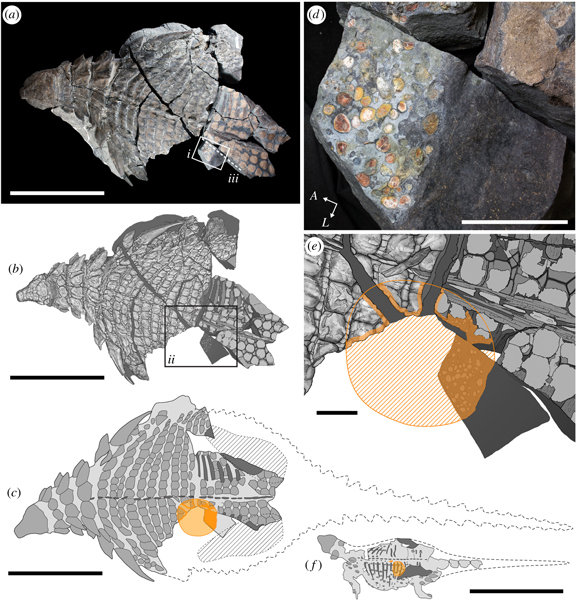
Picture credit: Brown et al (Royal Society Open Science)
Analysing the Cololite
Seven thin sections of the cololite were prepared which permitted the scientists to examine the cololite at a microscopic level.
The last meal of Borealopelta consisted of 88% leaf material, with a 7% minor stem/twigs component. Ferns dominated the leaf section and the bits of twigs showed distinct growth rings. In one of the twigs studied, the outermost ring is incomplete, this provides evidence for the time of year when the dinosaur died. Based on the incomplete growth ring, the researchers conclude that Borealopelta met its death in the late spring to mid-summer.
Carefully Prepared Slides Reveal the Dinosaur’s Last Meal at the Microscopic Level
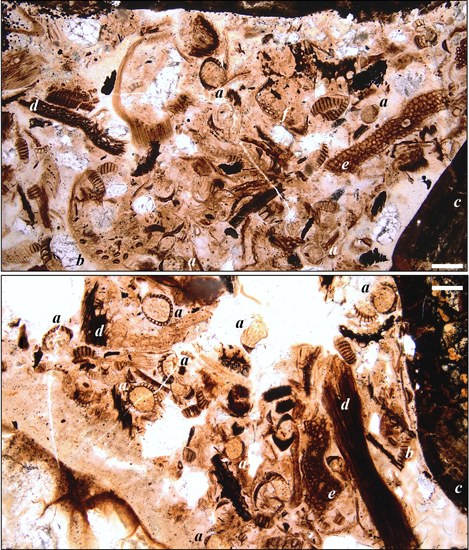
Picture credit: Brown et al (Royal Society Open Science)
Borealopelta markmitchelli was a Fussy Eater
The leaf fraction of the cololite is dominated (85%) by leptosporangiate ferns (subclass Polypodiidae), the largest group of ferns alive today. Although cycad remains were also found, they only represented 3% of the total amount. Trace amounts of foliage associated with conifers was also discovered. The researchers conclude that Borealopelta was selectively feeding on ferns, preferring to consume leptosporangiate ferns to the exclusion of Osmundaceae and eusporangiate ferns such as Marattiaceae with incidental consumption of cycad–cycadophyte and conifer leaves.
A Model of the Nodosaurid Borealopelta markmitchelli
Picture credit: Everything Dinosaur
The picture (above) shows the CollectA Prehistoric Life Borealopelta model.
To view this range of prehistoric animal figures: CollectA Age of Dinosaurs and Prehistoric Life Models.
To gain an understanding of the ancient flora in Borealopelta’s habitat, the researchers were able to determine what food plants were available to Borealopelta by studying the fossil leaves found in the contemporaneous Gates Formation, a rock unit exposed in coal mines in the Rocky Mountain foothills. This rock unit also preserves trackways left by armoured dinosaurs and is approximately the same age as the sediments that preserved Borealopelta.
In addition, the fossils of a small mollusc Murraia naiadiformis has been recorded from both the upper McMurray Formation (B. markmitchelli is known from the marine Wabiskaw Member of the fully marine Clearwater Formation which overlies the McMurray Formation) and the Gates Formation, supporting the idea that there is a link between these two depositional environments.
Some charcoal fragments were found as well, indicating that this nodosaur was feeding in an environment that had recently been burned. This aligns with growing evidence that forest fires were very common in the conifer and cycad-dominated forests around the world during the Early Cretaceous. This may also suggest the animal’s feeding ecology is linked to forest regrowth after a wildfire, such feeding behaviour is commonly observed in large herbivores alive today.
Comparison of the Cololite following Thin Section Microscopic Analysis
An Armoured Dinosaur with an Exceptional State of Preservation
The scientists are confident that given the exceptional state of preservation of Borealopelta, the fossil will yield further information helping palaeontologists to learn more about the Early Cretaceous environment of Alberta and the behaviour of armoured dinosaurs.
To read an Everything Dinosaur blog post about countershading identified in B. markmitchelli: Amazing Armoured Dinosaur Fossil Reveals Countershading.
Although, Borealopelta weighed around 1.3 tonnes, this nodosaurid was bristling with defensive armour. It was big, but in North America 110 million years ago there must have been a super-sized dinosaur predator capable of taking down such a monster. Scientists remain puzzled, here is an article that examines the beautifully preserved armour of Borealopelta and speculates on the theropods that shared its environment: The Armour of Borealopelta markmitchelli.
Everything Dinosaur acknowledges the assistance of a media release from the Royal Tyrrell Museum in the compilation of this article.
The scientific paper: “Dietary palaeoecology of an Early Cretaceous armoured dinosaur (Ornithischia; Nodosauridae) based on floral analysis of stomach contents” by Caleb M. Brown, David R. Greenwood, Jessica E. Kalyniuk, Dennis R. Braman, Donald M. Henderson, Cathy L. Greenwood and James F. Basinger published by Royal Society Open Science.
Visit the Everything Dinosaur website: Everything Dinosaur.


